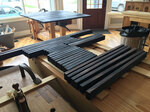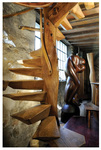We may receive a commission when you use our affiliate links. However, this does not impact our recommendations.

A few years ago I had a commission to design and build a large coffee table for a client in Chicago. I inlaid scatterings of bees on the panels at the sides and back to add some joyful sweetness to the otherwise-serious design.
A recent Instagram post showing the bees on one of the panels brought a lot of interest, so here’s the step-by-step technique I use for this type of inlay. It’s extremely simple (to the point of being embarrassingly crude) and wonderfully effective at evoking the lively buzzing of these hardworking creatures.
Materials needed:
- Marking knife
- Chisels and gouges, depending on the sizes and shapes you plan to use
- Sandpaper
- Laminate trimmer and 1/8″ cutter (optional)
- Pencil
- Oil-based enamel
- Veneer (you can saw your own)
- Thin brass sheet (available from many hardware stores; it should be thin enough to cut with scissors but not so thin that you can sand through it. I used .005″.)
- 5-minute epoxy
- Amber shellac

Draw the wings in pencil, adding some type of mark that will indicate which side goes up.

Cut the brass with scissors. (Just don’t expect them to stay sharp after such abuse.)

Here’s my first wing, cut out.

Cut out the second wing.

Put the wings together on paper to make sure they look good and will fit.

Place the wings (or at least one wing) on the veneer and draw the main part of the body with a fine pencil.

Cut the body out with a knife. Start by tracing the outline ever so gently, barely putting any pressure on the knife, to prevent the top from catching in the grain. Repeat, going a little deeper each time until you have cut through and can pop the shape out.


Clean up any roughness on the edges by rubbing the body across a flat piece of fine sandpaper. This is 320 grit. (Bring on the jokes about rubbing the body across sandpaper. I’m ready.)

Fasten your ground to the bench with clamps, or, as I did with this small piece, double sided tape. Start with the body; because it’s wood, you’ll be able to cut into it to inlay the main wing in a lifelike way.

Trace with your knife just inside the pencil line, starting lightly and increasing the pressure once you’ve scored the fibers. That way you won’t get caught in the grain and ruin the outline.

Set a laminate trimmer up with a 1/8″ straight cutter. These three test cuts allowed me to get the depth where I wanted it: just a tad deeper than the thickness of the veneer. Be extremely careful to control the laminate trimmer, as it’s easy to go beyond the outlines when routing such a small shape.

Use a variety of gouges and chisels to finish the cuts up to the knife line. I used a #3 sweep 6mm straight gouge, a #5 6mm fishtail gouge, a #11 2mm gouge, and a 1/8″ chisel. Because I have only outcannel gouges, I hold the gouge at an angle to keep the cut at the knife line sharp. The following image shows what I’m referring to.

Work around the shape, changing tools as necessary.

I use 5-minute epoxy because it works on wood and metal, in addition to allowing me to make progress more quickly.

Lay the body in place and press firmly. (No, it’s not pretty.)

I use 120-grit paper on a block to remove the excess adhesive and flatten the area. From this point on, you need to be careful to avoid cutting, scraping, or sanding too deeply .

Lay the first wing in place on the pattern and trace carefully around the edges with your knife. I just hold the wing in place with a fingernail, taking great care to avoid moving it when I shift position to reach the other side. As before, go very lightly on the first pass. Once you have a couple of passes you can move the wing and continue deepening the line if necessary.

Use carving tools as before to sneak up on the outline. You can use a laminate trimmer to remove the bulk of the waste, but I find it safer to do this by hand with a 1/8″ wide chisel. Note: It’s absolutely fine if the bottom of the ground is uneven. When you press the brass into place, the texture will have the effect of giving movement to the wings.

Removing waste from the ground with a 1/8″ chisel

Glue the wing in place as you did the body. Press firmly with a rounded tool tip (I used the plastic end of my Veritas marking knife, as shown in the next image) to ensure the wing is just below the surface of the surrounding material.

Pressing the brass into place

Repeat the process above with the second wing, then clean up with a block. Any texture in the wings resulting from the uneven ground will produce variation in the sheen, which will give the effect of movement.

I apply the stripes instead of inlaying them. You can do this with an oil-based paint, as I did here, or go the easy route and use a black Sharpie permanent marker. (Although some of the Sharpie colors turn out not to be “permanent,” black appears to be the Energizer Bunny.)


After the paint has dried completely, scrape away any stray strokes using a sharp chisel.

I applied a coat of amber shellac to give the pale veneer a golden buzz and seal the surrounding mahogany.
– Nancy Hiller
 English Arts & Crafts Furniture explores the Arts & Crafts movement with a unique focus on English designers. Through examination of details, techniques, and historical context, as well as projects, you’ll discover what sets these designers and their work apart from those that came before and after, as well as gain a deeper understanding of the Arts & Crafts movement and its influence.
English Arts & Crafts Furniture explores the Arts & Crafts movement with a unique focus on English designers. Through examination of details, techniques, and historical context, as well as projects, you’ll discover what sets these designers and their work apart from those that came before and after, as well as gain a deeper understanding of the Arts & Crafts movement and its influence.
Here are some supplies and tools we find essential in our everyday work around the shop. We may receive a commission from sales referred by our links; however, we have carefully selected these products for their usefulness and quality.








